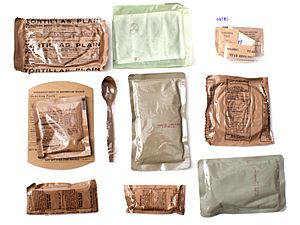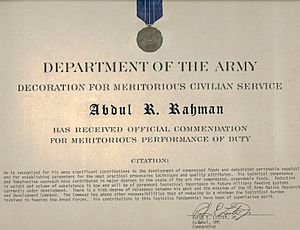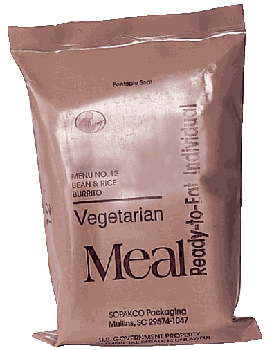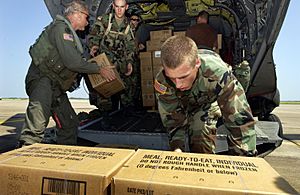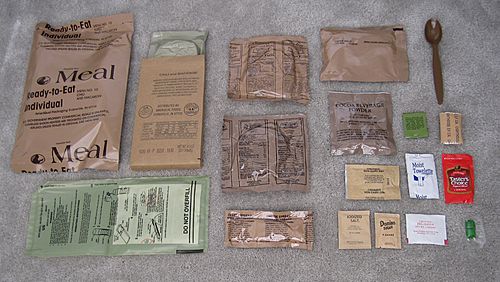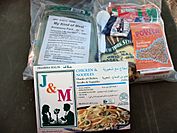Meal, Ready-to-Eat facts for kids
The Meal, Ready-to-Eat (MRE) is a special, ready-to-eat meal for soldiers. It comes in a lightweight package. The United States military buys MREs for soldiers to use when they are in combat or in places where there are no kitchens. MREs do not need to be kept in a refrigerator. They replaced older types of military food in 1981. MREs have also been given to people during natural disasters.
Contents
The Story of MREs
Early Military Meals
The very first food for U.S. soldiers was decided during the American Revolutionary War. It was enough food for one person for a day. This usually included beef, peas, and rice. During the American Civil War, the military started using canned foods. Later, soldiers received full meal kits with canned meat, bread, coffee, sugar, and salt.
In World War I, heavy canned meats were replaced with lighter dried meats. This helped soldiers carry more food when they walked long distances. For World War II, new field meals were made, like the Mountain ration. But to save money, the military often used heavy canned C rations. This happened even if the soldiers were in tough environments.
How MREs Were Created
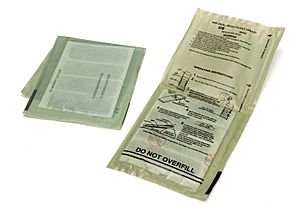
After many years of giving prepared food to soldiers, military leaders learned something important. They realized that just giving soldiers healthy food was not enough. Soldiers in different places and situations needed different kinds of food to enjoy eating it for a long time. Also, giving soldiers food they liked would make sure they ate the whole meal and got all the nutrition.
It was also important to make meals lighter. Special forces often had to carry heavy gear on long missions. Lighter food was a big help. In 1963, the Department of Defense started working on the "Meal, Ready to Eat." This new meal would use modern food science to create a lighter replacement for canned meals.
Early MRE ideas included freeze-dried foods. Dr. Abdul Rahman helped develop these. He later received an award for his work. But the military needed a meal that didn't need water added to it. Dr. Rauno A. Lampi then worked on improving a special pouch. This pouch could hold wet food and keep it fresh for three to ten years. This food could be easily shipped, carried, and eaten right from the package. The first MREs were given to soldiers in 1981. They became standard for all soldiers in 1986.
What MREs Need to Do
Each MRE meal gives a soldier about 1,200 calories. They are meant to be eaten for up to 21 days. By then, soldiers should get fresh food. MREs are designed to last at least three years if stored correctly.
The packaging for MREs must be very strong. They need to survive being dropped from a parachute from 380 meters (about 1,247 feet). They also need to survive drops of 30 meters (about 98 feet) without a parachute. The packaging must keep the food good for three and a half years at 27°C (80°F). It must also last nine months at 38°C (100°F). And it needs to handle short times in very cold or very hot weather.
Each MRE weighs between 510 and 740 grams (about 1.1 to 1.6 pounds). This depends on what's inside. Because MREs contain water, they weigh more than freeze-dried meals with the same calories.
Selling MREs to the Public
MREs are marked with a warning: "U.S. Government Property, Commercial Resale is Unlawful." This means they are not supposed to be sold to the public. The government wants MREs to go to soldiers and authorized groups. If MREs are sold to the public, it means they are not reaching the people they were made for.
Sometimes, MREs sold online are older and closer to their expiration date. They might have been found at yard sales or even in dumpsters. The government pays about $7.25 for each MRE. However, regular people can buy similar MREs directly from companies that make them for the government. These are very much like the official military MREs.
In some countries, like the Philippines, the government has stopped MREs from being sold in local markets.
What's Inside an MRE?
A typical MRE includes several items:
- Main course (the "main" dish)
- Side dish
- Dessert or a snack (like candy or a special bar)
- Crackers or bread
- A spread like cheese, peanut butter, or jelly
- Powdered drink mix (fruit drink, cocoa, coffee, or tea)
- A plastic spoon (sometimes a full set of utensils)
- A flameless ration heater (FRH) to warm the food
- A bag for mixing drinks
- An accessory pack with:
- Chewing gum
- Matches
- A napkin or toilet paper
- A moist towelette
- Seasonings like salt, pepper, sugar, creamer, or Tabasco sauce
- Freeze-dried coffee powder
Many items in MREs have extra nutrients added. Also, the military tries to give soldiers fresh food whenever possible, especially during training.
How MRE Menus Have Changed
The military always tries to make MREs taste better for soldiers. They ask for feedback to change the menus and ingredients. Here are some of the main dishes that have been in MREs over the years:
| Menus 1981 to 1997 | ||||||
|---|---|---|---|---|---|---|
| # | MRE I – VII (1981–87) | MRE VIII – XII (1988–92) | MRE XIII – XIV (1993–94) | MRE XV (1995) | MRE XVI (1996) | MRE XVII (1997) |
| 1 | Pork Patty | Pork w/ Rice in BBQ Sauce | Pork w/ Rice in BBQ Sauce | Pork w/ Rice in BBQ Sauce | Beef Steak | Beef Steak |
| 2 | Ham & Chicken loaf | Corned Beef Hash | Corned Beef Hash | Chili w/ Macaroni | Tuna w/ Noodles | Boneless Pork Chop w/ Noodles |
| 3 | Beef Patty | Chicken Stew | Chicken Stew | Chicken Stew | Chicken Stew | Chicken Stew |
| 4 | Beef slices in BBQ sauce | Omelet with Ham | Omelet with Ham | Grilled Chicken | Ham Slice | Ham Slice |
| 5 | Beef Stew | Spaghetti w/ Meat Sauce | Spaghetti w/ Meat Sauce | Spaghetti w/ Meat Sauce | Spaghetti w/ Meat Sauce | Chicken w/ Noodles |
| 6 | Frankfurters w/ Beans | Chicken a la King | Smokey Franks | Smokey Franks | Smokey Franks | Smokey Franks |
| 7 | Turkey Diced w/ Gravy | Beef Stew | Beef Stew | Beef Stew | Beef Stew | Pork Chow Mein |
| 8 | Beef Diced w/ Gravy | Ham Slice | Ham Slice | Ham Slice | Chicken w/ Rice | Chicken w/ Rice |
| 9 | Chicken à la King | Meatballs w/ Tomato Sauce | Pork Chow Mein | Pork Chow Mein | Pork Chow Mein | Beef Stew |
| 10 | Meatballs & BBQ sauce | Tuna w/ Noodles | Tuna w/ Noodles | Tuna w/ Noodles | Chili w/ Macaroni | Chili w/ Macaroni |
| 11 | Ham slices | Chicken w/ Rice | Chicken w/ Rice | Chicken w/ Rice | Pasta w/ Vegetables | |
| 12 | Ground Beef w/ Spiced Sauce | Escalloped Potatoes w/ Ham | Escalloped Potatoes w/ Ham | Escalloped Potatoes w/ Ham | Cheese Tortellini | Cheese Tortellini |
| 13 | Chicken Loaf | Pork w/ Rice | Pork w/ Rice | |||
| 14 | Chicken Parmesan | Chicken Parmesan | ||||
| 15 | Grilled Chicken | Grilled Chicken | ||||
| 16 | Escalloped Potatoes w/ Ham | Tuna w/ Noodles | ||||
| 17 | Beef Ravioli | |||||
| 18 | Turkey Breast w/ Gravy & Potatoes | |||||
| 19 | Beef w/ Mushrooms | |||||
| 20 | Spaghetti w/ Meat Sauce | |||||
| Menus 1998 to 2003 | ||||||
|---|---|---|---|---|---|---|
| # | MRE XVIII (1998) | MRE XIX (1999) | MRE XX (2000) | MRE XXI (2001) | MRE XXII (2002) | MRE XXIII (2003) |
| 1 | Beef Steak | Beef Steak | Grilled Beefsteak | Grilled Beefsteak | Beefsteak w/ Mushrooms | Beefsteak w/ Mushrooms |
| 2 | Boneless Pork Chop w/ Noodles | Boneless Pork Jamaican | Boneless Pork Chop | Boneless Pork Chop | Jamaican Pork Chop w/ Noodles | Pork Rib |
| 3 | Chicken Stew | Beef Teriyaki | Beef Teriyaki | Beef Ravioli | Beef Ravioli | Beef Ravioli |
| 4 | Ham Slice | Ham Slice | Country Captain Chicken | Country Captain Chicken | Country Captain Chicken | Country Captain Chicken |
| 5 | Chicken w/ Noodles | Grilled Chicken Breast | Grilled Chicken Breast | Grilled Chicken Breast | Grilled Chicken Breast | Chicken Breast |
| 6 | Grilled Chicken | Chicken w/ Noodles | Chicken w/ Noodles | Chicken w/ Thai Sauce | Chicken w/ Thai Sauce | Chicken w/ Thai Sauce |
| 7 | Pork Chow Mein | Chicken w/ Salsa | Chicken w/ Salsa | Chicken w/ Salsa | Chicken w/ Salsa | Chicken w/ Salsa |
| 8 | Chicken w/ Rice | Chicken w/ Rice | Chicken and Rice | Chicken and Rice | Beef Patty | Beef Patty |
| 9 | Beef Stew | Beef Stew | Beef Stew | Beef Stew | Beef Stew | Beef Stew |
| 10 | Chili w/ Macaroni | Chili w/ Macaroni | Chili and Macaroni | Chili and Macaroni | Chili and Macaroni | Chili and Macaroni |
| 11 | Pasta w/ Vegetables | Pasta w/ Vegetables in Tomato Sauce | Pasta w/ Vegetables in Tomato Sauce | Pasta w/ Vegetables in Tomato Sauce | Pasta w/ Vegetables in Tomato Sauce | Pasta w/ Vegetables in Tomato Sauce |
| 12 | Cheese Tortellini | Rice & Bean Burrito | Rice & Bean Burrito | Rice & Bean Burrito | Rice & Bean Burrito | Black Bean & Rice Burrito |
| 13 | Thai Chicken | Cheese Tortellini | Cheese Tortellini | Cheese Tortellini | Cheese Tortellini | Cheese Tortellini |
| 14 | Chicken w/ Cavatelli | Pasta w/ Vegetables in Alfredo Sauce | Pasta w/ Vegetables in Alfredo Sauce | Pasta w/ Vegetables in Alfredo Sauce | Pasta w/ Vegetables in Alfredo Sauce | Manicotti w/ Vegetables |
| 15 | Beef Franks | Beef Franks | Beef Frankfurters | Beef Enchilada | Beef Enchilada | Beef Enchiladas |
| 16 | Bean & Rice Burrito | Chicken w/ Thai Sauce | Thai Chicken | Chicken w/ Noodles | Chicken w/ Noodles | Chicken w/ Noodles |
| 17 | Beef Ravioli | Beef Ravioli | Beef Ravioli | Beef Teriyaki | Beef Teriyaki | Beef Teriyaki |
| 18 | Turkey Breast w/ Gravy & Potatoes | Turkey Breast w/ Gravy & Potatoes | Turkey Breast w/ Gravy & Potatoes | Turkey Breast w/ Gravy & Potatoes | Turkey Breast w/ Gravy & Potatoes | Turkey Breast w/ Gravy & Potatoes |
| 19 | Beef w/ Mushrooms | Beef w/ Mushrooms | Beef w/ Mushrooms | Beef w/ Mushrooms | Beef w/ Mushrooms | Roast Beef |
| 20 | Spaghetti w/ Meat Sauce | Spaghetti w/ Meat Sauce | Spaghetti w/ Meat Sauce | Spaghetti w/ Meat Sauce | Spaghetti w/ Meat Sauce | Spaghetti w/ Meat Sauce |
| 21 | Beef Teriyaki | Chicken Stew | Chicken Tetrazzini | Chicken Tetrazzini | Chicken Tetrazzini | Chicken Tetrazzini |
| 22 | Chicken w/ Salsa | Pork Chow Mein | Pork Chow Mein | Jambalaya | Jambalaya | Jambalaya |
| 23 | Meat Loaf w/ Gravy | Chicken w/ Cavatelli | Chicken w/ Cavatelli | Chicken w/ Cavatelli | Chicken w/ Cavatelli | Chicken w/ Cavatelli |
| 24 | Pasta w/ Alfredo Sauce | Meat Loaf w/ Gravy | Meat Loaf w/ Gravy | Meat Loaf w/ Gravy | Meat Loaf w/ Gravy | Meat Loaf w/ Gravy |
| Menus 2004 to 2009 | ||||||
|---|---|---|---|---|---|---|
| # | MRE XXIV (2004) | MRE XXV (2005) | MRE XXVI (2006) | MRE XXVII (2007) | MRE XXVIII (2008) | MRE XXIX (2009) |
| 1 | Beef Steak | Beef Steak | Chili w/ Beans | Chili w/ Beans | Chili w/ Beans | Chili w/ Beans |
| 2 | Pork Rib | Pork Rib | Pork Rib | Pork Rib | Pork Rib | Pork Rib |
| 3 | Beef Ravioli | Beef Ravioli | Beef Ravioli | Beef Ravioli | Beef Ravioli | Beef Ravioli |
| 4 | Country Captain Chicken | Cheese & Vegetable Omelet | Cheese & Vegetable Omelet | Cheese & Vegetable Omelet | Cheese & Vegetable Omelet | Maple Sausage |
| 5 | Grilled Chicken Breast | Chicken Breast | Chicken Breast | Chicken Breast | Chicken Breast | Chicken Breast |
| 6 | Chicken w/ Thai Sauce | Chicken Fajitas | Chicken Fajitas | Chicken Fajitas | Chicken w/ Noodles | Chicken w/ Noodles |
| 7 | Chicken w/ Salsa | Chicken w/ Salsa | Chicken w/ Salsa | Chicken w/ Salsa | Meatloaf w/ Gravy | Beef Brisket |
| 8 | Beef Patty | Beef Patty | Beef Patty | Beef Patty | Beef Patty | Beef Patty |
| 9 | Beef Stew | Beef Stew | Beef Stew | Beef Stew | Beef Stew | Beef Stew |
| 10 | Chili and Macaroni | Chili and Macaroni | Tuna | Tuna in Pouch | Chili and Macaroni | Chili and Macaroni |
| 11 | Pasta w/ Vegetables in Tomato Sauce | Pasta w/ Vegetables in Tomato Sauce | Spicy Penne Pasta | Vegetable Manicotti | Vegetable Lasagna | Vegetable Lasagna |
| 12 | Veggie Burger w/ BBQ Sauce | Veggie Burger w/ BBQ Sauce | Veggie Burger w/ BBQ Sauce | Veggie Burger w/ BBQ Sauce | Veggie Burger w/ BBQ Sauce | Veggie Burger w/ BBQ Sauce |
| 13 | Cheese Tortellini | Cheese Tortellini | Cheese Tortellini | Cheese Tortellini | Cheese Tortellini | Cheese Tortellini |
| 14 | Manicotti w/ Vegetables | Manicotti w/ Vegetable | Manicotti w/ Vegetable | Spicy Penne Pasta w/ Vegetarian Sausage | Spicy Penne Pasta w/ Vegetarian Sausage | Spicy Penne Pasta w/ Vegetarian Sausage |
| 15 | Beef Enchiladas | Beef Enchiladas | Beef Enchiladas | Beef Enchiladas | Beef Enchiladas | Beef Enchiladas |
| 16 | Chicken w/ Noodles | Chicken w/ Noodles | Chicken w/ Noodles | Chicken Fajita | Chicken Fajita | Chicken Fajita |
| 17 | Beef Teriyaki | Sloppy Joe Filling | Sloppy Joe | Sloppy Joe Filling | Sloppy Joe Filling | Sloppy Joe Filling |
| 18 | Cajun Rice, Beans & Sausage | Cajun Rice & Sausage | Cajun Rice, Beans, & Sausage | Meatballs w/ Marinara | Meatballs w/ Marinara | Meatballs w/ Marinara |
| 19 | Roast Beef | Roast Beef w/ Vegetables | Roast Beef w/ Vegetables | Pot Roast w/ Vegetables | Pot Roast w/ Vegetables | Pot Roast w/ Vegetables |
| 20 | Spaghetti w/ Meat Sauce | Spaghetti w/ Meat Sauce | Spaghetti w/ Meat Sauce | Spaghetti w/ Meat Sauce | Spaghetti w/ Meat Sauce | Spaghetti w/ Meat Sauce |
| 21 | Chicken Tetrazzini | Chicken Tetrazzini | Chicken Tetrazzini | Chili & Macaroni | Tuna in Pouch | Tuna in Pouch |
| 22 | Jambalaya | Jambalaya | Jambalaya | Chicken w/ Dumplings | Chicken w/ Dumplings | Chicken w/ Dumplings |
| 23 | Chicken w/ Cavatelli | Chicken w/ Cavatelli | Chicken w/ Cavatelli | Chicken w/ Cavatelli | Chicken Pesto & Pasta | Chicken Pesto & Pasta |
| 24 | Meat Loaf w/ Gravy | Meat Loaf w/ Gravy | Meat Loaf w/ Gravy | Meat Loaf w/ Gravy | Chicken w/ Salsa | Buffalo Chicken |
| Menus 2010 to 2015 | ||||||
|---|---|---|---|---|---|---|
| # | MRE XXX (2010) | MRE XXXI (2011) | MRE XXXII (2012) | MRE XXXIII (2013) | MRE XXXIV (2014) | MRE XXXV (2015) |
| 1 | Chili w/ Beans | Chili w/ Beans | Chili w/ Beans | Chili w/ Beans | Chili w/ Beans | Chili w/ Beans |
| 2 | Pork Rib | Chicken Fajita | Chicken Fajita | Chicken Fajita | Shredded BBQ Beef | Shredded BBQ Beef |
| 3 | Beef Ravioli | Beef Ravioli | Chicken with Noodles | Chicken with Noodles | Chicken with Noodles | Chicken with Noodles |
| 4 | Maple Sausage | Maple Sausage | Pork Sausage w/ Gravy | Pork Sausage w/ Gravy | Spaghetti w/ Meat Sauce | Spaghetti w/ Meat Sauce |
| 5 | Mediterranean Chicken | Mediterranean Chicken | Chicken, Tomato, Feta | Mediterranean Chicken | Mediterranean Chicken | Diced Chicken |
| 6 | Chicken w/ Noodles | Beef Patty | Beef Roast w/ Vegetables | Beef Taco | Beef Taco | Beef Taco |
| 7 | Beef Brisket | Beef Brisket | Beef Brisket | Beef Brisket | Beef Brisket | Beef Brisket |
| 8 | Meatballs w/ Marinara Sauce | Meatballs w/ Marinara Sauce | Meatballs w/ Marinara Sauce | Meatballs w/ Marinara Sauce | Meatballs w/ Marinara Sauce | Meatballs w/ Marinara Sauce |
| 9 | Beef Stew | Beef Stew | Beef Stew | Beef Stew | Beef Stew | Beef Stew |
| 10 | Chili and Macaroni | Chili and Macaroni | Chili and Macaroni | Chili and Macaroni | Chili and Macaroni | Chili and Macaroni |
| 11 | Vegetable Lasagna | Vegetable Lasagna | Vegetable Lasagna | Vegetable Lasagna | Vegetarian Taco Pasta | Vegetarian Taco Pasta |
| 12 | Veggie Burger w/ BBQ Sauce | Spicy Penne Pasta | Spicy Penne Pasta | Spicy Penne Pasta | Spicy Penne Pasta | Spicy Penne Pasta |
| 13 | Cheese Tortellini | Cheese Tortellini | Cheese Tortellini | Cheese Tortellini | Cheese Tortellini | Cheese Tortellini |
| 14 | Spicy Penne Pasta w/ Vegetarian Sausage | Ratatouille | Ratatouille | Ratatouille | Ratatouille | Ratatouille |
| 15 | Southwest Beef & Black Beans | Southwest Beef & Black Beans | Mexican Style Chicken Stew | Mexican Style Chicken Stew | Mexican Style Chicken Stew | Mexican Style Chicken Stew |
| 16 | Chicken Fajita | Pork Rib | Pork Rib | Pork Rib | Pork Rib | Pork Rib |
| 17 | Sloppy Joe | Pork Sausage w/ Gravy | Maple Sausage | Maple Sausage | Maple Sausage | Maple Sausage |
| 18 | Beef Patty | Chicken w/ Noodles | Beef Ravioli | Beef Ravioli | Beef Ravioli | Beef Ravioli |
| 19 | Beef Roast w/ Vegetables | Beef Roast w/ Vegetables | Sloppy Joe | Jalapeno Pepper Jack Beef Patty | Jalapeno Pepper Jack Beef Patty | Jalapeno Pepper Jack Beef Patty |
| 20 | Spaghetti w/ Meat Sauce | Spaghetti w/ Meat Sauce | Spaghetti w/ Meat Sauce | Spaghetti w/ Meat Sauce | Pork Sausage w/ Gravy | Hash Brown Potatoes w/ Bacon |
| 21 | Tuna | Lemon Pepper Tuna | Lemon Pepper Tuna | Lemon Pepper Tuna | Lemon Pepper Tuna | Lemon Pepper Tuna |
| 22 | Chicken and Dumplings | Sloppy Joe | Asian Beef Strips | Asian Beef Strips | Asian Beef Strips | Asian Style Beef Strips w/ Peppers |
| 23 | Chicken Pesto Pasta | Chicken Pesto Pasta | Chicken Pesto Pasta | Chicken Pesto Pasta | Chicken Pesto Pasta | Chicken Pesto Pasta |
| 24 | Buffalo Chicken | Buffalo Chicken | Southwest Beef and Black Beans | Southwest Beef and Black Beans | Southwest Beef and Black Beans | Southwest Beef and Black Beans |
| Menus 2016 to 2019 | ||||
|---|---|---|---|---|
| # | MRE XXXVI (2016) | MRE XXXVII (2017) | MRE XXXVIII (2018) | MRE XXXIX (2019) |
| 1 | Chili w/ Beans | Chili w/ Beans | Chili w/ Beans | Chili w/ Beans |
| 2 | Shredded BBQ Beef | Shredded BBQ Beef | Shredded BBQ Beef | Shredded BBQ Beef |
| 3 | Chicken w/ Egg Noodles & Vegetables | Chicken w/ Egg Noodles & Vegetables | Chicken w/ Egg Noodles & Vegetables | Chicken w/ Egg Noodles & Vegetables |
| 4 | Spaghetti w/ Meat Sauce | Spaghetti w/ Meat Sauce | Spaghetti w/ Meat Sauce | Spaghetti w/ Meat Sauce |
| 5 | Chili and Macaroni | Chicken Chunks | Chicken Chunks | Chicken Chunks |
| 6 | Beef Taco | Beef Taco | Beef Taco | Beef Taco |
| 7 | Beef Brisket | Beef Brisket | Beef Brisket | Beef Brisket |
| 8 | Meatballs w/ Marinara Sauce | Meatballs w/ Marinara Sauce | Meatballs w/ Marinara Sauce | Meatballs w/ Marinara Sauce |
| 9 | Beef Stew | Beef Stew | Beef Stew | Beef Stew |
| 10 | Chicken Chunks | Chili and Macaroni | Chili and Macaroni | Chili and Macaroni |
| 11 | Vegetarian Taco Pasta | Vegetarian Taco Pasta | Vegetarian Taco Pasta | Vegetarian Taco Pasta |
| 12 | Elbow Macaroni and Tomato Sauce | Elbow Macaroni and Tomato Sauce | Elbow Macaroni and Tomato Sauce | Elbow Macaroni and Tomato Sauce |
| 13 | Cheese Tortellini | Cheese Tortellini | Cheese Tortellini | Cheese Tortellini |
| 14 | Spinach Mushrooms & Cream Sauce Fettuccine | Spinach Mushrooms & Cream Sauce Fettuccine | Spinach Mushrooms & Cream Sauce Fettuccine | Spinach Mushrooms & Cream Sauce Fettuccine |
| 15 | Maple Sausage | Mexican Style Chicken Stew | Mexican Style Chicken Stew | Mexican Style Chicken Stew |
| 16 | Pork Rib | Chicken Burrito Bowl | Chicken Burrito Bowl | Chicken Burrito Bowl |
| 17 | Mexican Style Chicken Stew | Maple Sausage | Maple Sausage | Maple Sausage |
| 18 | Beef Ravioli | Beef Ravioli | Beef Ravioli | Beef Ravioli |
| 19 | Jalapeno Pepper Jack Beef Patty | Jalapeno Pepper Jack Beef Patty | Jalapeno Pepper Jack Beef Patty | Jalapeno Pepper Jack Beef Patty |
| 20 | Hash Brown Potatoes w/ Bacon | Hash Brown Potatoes w/ Bacon | Hash Brown Potatoes w/ Bacon | Hash Brown Potatoes w/ Bacon |
| 21 | Lemon Pepper Tuna | Lemon Pepper Tuna | Lemon Pepper Tuna | Lemon Pepper Tuna |
| 22 | Asian Style Beef Strips w/ Vegetables | Asian Style Beef Strips w/ Vegetables | Asian Style Beef Strips w/ Vegetables | Beef Goulash |
| 23 | Chicken Pesto Pasta | Chicken Pesto Pasta | Pepperoni Pizza Slice | Pepperoni Pizza Slice |
| 24 | Southwest Beef and Black Beans | Southwest Beef and Black Beans | Southwest Beef and Black Beans | Southwest Beef and Black Beans |
How to Read MRE Dates
MRE cases usually show the production date like this: Month/Day/Year (e.g., 11/24/1996 for November 24, 1996). After this, there's a 4-digit "Lot Number." This number is also on the individual items inside the MRE. The first digit is the last digit of the year (so '1' could mean 2001 or 2011). The next three digits show the day of the year (from 001 to 366). For example, "1068" means the 68th day of 2001 or 2011 (March 9).
MRE cases also have an "Inspection / Test Date." This is like the packing date. For example, "10/94" means October 1994. MREs should be kept in a cool, dry place. If they are stored at 80°F (27°C) for three years in a row, they reach the end of their shelf life. Military food experts check them. Their shelf life can sometimes be longer than the inspection date. MREs are thrown away after five years.
MREs for Everyone
MREs have been given to people during natural disasters. The National Guard has provided MREs to the public during hurricanes like Katrina, Ike, and Sandy. They were also used during the 2011 Super Outbreak of tornadoes. Because so many people got MREs, some jokes were made during Mardi Gras in New Orleans. People even wore clothes made from MRE packets!
Some people have wondered if MREs are good for people who are not in combat. MREs are designed for soldiers who burn a lot of calories and sweat a lot. They have high fat and salt content. This might not be ideal for people who are not very active. For these situations, other special meals are available.
What People Say About MREs
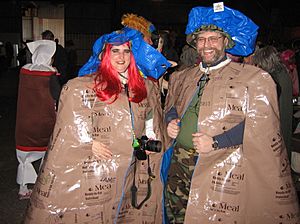
Some of the first MRE main dishes were not very tasty. People gave them funny nicknames like "Meals Rejected by Everyone." Even though the quality has gotten better, some of these nicknames have stuck. One joke was that MREs were "Three Lies for the Price of One... it's not a Meal, it's not Ready, and you can't Eat it."
MREs have a low amount of fiber. This can sometimes cause tummy problems for some people. So, they were also called "Meals Requiring Enemas." There's a myth that the gum in MREs has a laxative, but that's not true. However, the gum is sweetened with xylitol, which can be a mild laxative. The crackers in the MRE do have extra vegetables to help with digestion.
There's a funny belief among soldiers about the Charms candies that come with some MREs. Soldiers think they are bad luck, especially if you eat them. Some say this started because people just didn't like them.
In 2007, a newspaper asked three expert chefs to taste 18 MRE meals. None of the meals scored higher than 5.7 out of 10. The chicken fajita meal was especially disliked, getting an average score of 1.3. In the early days of the war in Afghanistan, soldiers would trade MREs. A single French 24-hour combat meal could be traded for at least five American MREs.
The vegetable cheese omelet MRE, introduced in 2005, is often called the worst MRE ever. Soldiers called it the "Vomelet" because of how it looked and tasted. It was stopped in 2009.
Other Types of Military Meals
The MRE has led to other similar military meals.
- Aircrew Build to Order Meal Module (ABOMM) are special MREs for flight crews and tank operators. They are made to be eaten easily without utensils while operating vehicles.
- Meal, Religious, Kosher/Halal are for soldiers with special religious food rules. These meals have the same nutrition but do not contain forbidden ingredients. They come in special packaging.
- The Humanitarian Daily Ration (HDR) is a meal for refugees and people who have been displaced. It is designed to feed one person for a whole day. It avoids animal products and alcohol to fit many cultures and religions. These meals are often air-dropped.
- Meal, Cold Weather (MCW) is for very cold places. Regular MREs can freeze solid in extreme cold. The MCW has freeze-dried food that needs hot water. It also has more calories and fat.
- Meal, Alternative Regionally Customized (MARC) meals are vegetarian. This helps avoid conflicts with different food rules. Many of these meals have a Southeast Asian or Indian style.
- Meal, Long Range Patrol (LRP) is like the MCW but lighter. It's for troops who might not get new supplies often.
- Modular Operational Rations Enhancement (MORE) are extra supplements for troops in very tough training or operations.
- Tailored Operational Training Meal (TOTM) is a lower-calorie meal for training that is not as intense. It helps troops get used to MREs without eating too many calories.
- Unitized Group Ration (UGR) is like an MRE but for large groups of people. It comes in metal trays that are heated and then opened.
- Food Packet, Survival, General Purpose, Improved (FPSGPI) is a small, easy-to-carry meal for emergencies, like for pilots.
- The "Jimmy Dean" is a pre-packaged sandwich meal sometimes given to soldiers as an alternative to MREs.
Images for kids
-
A pair of flameless ration heaters. The instructions advise that they should be rested against a "rock or something."
-
New Orleans Mardi Gras revelers in 2006 dressed in coats made from MRE packaging
See also
 In Spanish: Meal, Ready-to-Eat para niños
In Spanish: Meal, Ready-to-Eat para niños



